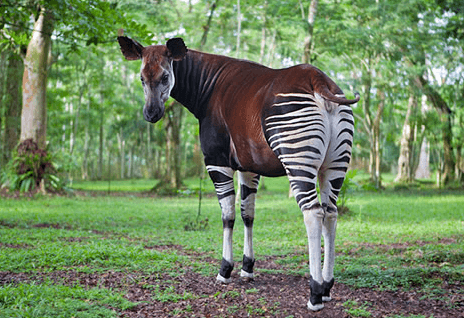Let's talk about Democratic Republic of the Congo National Animal. The Democratic Republic of the Congo (DRC) is a country in Central Africa known for its rich biodiversity and unique wildlife. Among its many natural wonders, the Okapi stands out as the national animal of the DRC. In this article, we will delve into the fascinating world of the Okapi, exploring its characteristics, habitat, conservation status, and significance to the Congolese people. So, let's embark on a journey to discover the wonders of the Democratic Republic of the Congo's national animal, the Okapi.
Physical Characteristics of the Okapi
The Okapi possesses a set of remarkable physical attributes. It stands at an average height of around 5 feet (1.5 meters) at the shoulder, with a body length of approximately 8 feet (2.5 meters). The animal's most distinctive feature is its coat, which is velvety and rich brown in color, adorned with horizontal white stripes on its hindquarters. These markings serve as camouflage in the dappled sunlight of the rainforest, allowing the Okapi to blend seamlessly into its environment.
Habitat and Distribution
The Okapi is exclusively found in the dense rainforests of the northeastern regions of the Democratic Republic of the Congo. These forests provide the Okapi with the ideal habitat, characterized by a combination of dense vegetation, ample water sources, and a favorable climate. The Okapi's limited distribution is due to its highly specialized ecological requirements, making it a true symbol of the Congolese rainforest.
Behavior and Diet
Okapis are generally solitary animals, preferring to live in secluded areas of the rainforest. They are known for their secretive nature, which makes them a challenge to study and observe in the wild. These herbivorous animals primarily feed on leaves, buds, fruits, and fungi found within their forest habitat. Their long, prehensile tongues enable them to reach and strip leaves from branches, allowing for efficient foraging.
Cultural Significance of Democratic Republic of the Congo National Animal
The Okapi holds significant cultural value for the people of the Democratic Republic of the Congo. It has become a national symbol, representing the country's unique biodiversity and serving as a source of pride for its citizens. The Okapi's image can be found on various national emblems, coins, and postage stamps, solidifying its place in Congolese heritage.
Conservation Efforts for Democratic Republic of the Congo National Animal
Due to habitat destruction, illegal hunting, and political instability, the Okapi faces numerous threats to its survival. However, conservation organizations and the Congolese government have taken active measures to protect this endangered species. Efforts include establishing protected areas, implementing anti-poaching initiatives, and raising awareness about the importance of conserving the Okapi and its habitat.
The Future of the Democratic Republic of the Congo National Animal
While challenges persist, there is hope for the Okapi's future. Continued conservation efforts and sustainable development practices are essential in ensuring the long-term survival of this remarkable species. By safeguarding the rainforest and collaborating with local communities, we can help preserve the Okapi and its unique place within the Democratic Republic of the Congo's natural heritage.
Conclusion
The Okapi, as the national animal of the Democratic Republic of the Congo, represents the country's rich biodiversity and serves as a symbol of its commitment to conservation. With its distinct appearance and elusive nature, the Okapi captivates the imagination of both locals and visitors alike. By protecting its habitat and raising awareness, we can secure a future where this magnificent creature continues to thrive in the heart of the Congolese rainforest.
FAQs
Q1: How did the Okapi become the national animal of the Democratic Republic of the Congo?
The Okapi was chosen as the national animal of the Democratic Republic of the Congo due to its unique status as a native species found exclusively in the country's rainforests. It represents the country's rich biodiversity and serves as a symbol of national pride.
Q2: Is the Okapi related to the giraffe?
Yes, despite its resemblance to a mix between a giraffe and a zebra, the Okapi is more closely related to the giraffe. It shares common ancestry with giraffes and exhibits similar features such as long necks and ossicones.
Q3: Are Okapis endangered?
Yes, Okapis are classified as endangered by the International Union for Conservation of Nature (IUCN). Habitat loss, illegal hunting, and political instability pose significant threats to their survival.
Q4: Can Okapis be found outside of the Democratic Republic of the Congo?
No, Okapis are endemic to the rainforests of the Democratic Republic of the Congo. Their limited distribution makes them a truly unique and special species found exclusively in this region.
Q5: How can I support Okapi conservation efforts?
You can contribute to Okapi conservation efforts by supporting reputable conservation organizations working in the Democratic Republic of the Congo, raising awareness about the Okapi's plight, and advocating for sustainable practices that protect their habitat.
References
- "Okapia johnstoni" by IUCN Red List of Threatened Species:
Link: https://www.iucnredlist.org/species/15188/50193406
- "Okapi" by San Diego Zoo:
Link: https://animals.sandiegozoo.org/animals/okapi
- "Okapi: Wildlife summary" by WWF:
Link: https://www.worldwildlife.org/species/okapi
